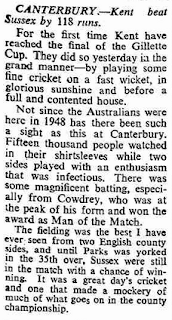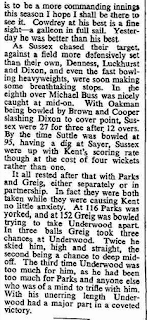Maidstone
week was always a highlight of the Kentish season. I
wrote about cricket at Mote Park a couple of years ago. It was at Maidstone
that writers could bring out the thesaurus of high summer: shimmering…baking…sweltering,
cricket played to the sound of eggs frying on the pavement. Much of this is
nostalgia cleansing the memory of course; it was as likely to pour down there
as anywhere else, but for many of us Maidstone week was the first element of the
holy trinity of cricket watching in Kent, along with the weeks at Canterbury
and Folkestone that followed, though in 1967 it would be another five years
until I watched cricket at the Mote.
It was a
cracker of a week, with an exploding pitch and a match-saving last-wicket
stand. The week began with Kent making 296 in the first innings against
Hampshire. John Shepherd was now established at No 3, and followed his
semi-final 77 with 72 here. Shepherd remained at No 3 for the rest of the
season, but never batted as high thereafter. He had the talent, but it was to
be his lot to carry the seam attack for the next decade and more, so he usually
found himself down at No 8, which was something of a waste.
On Sunday,
10,000 crammed into a ground that had reasonable seating for no more than a
tenth of them; this just a few days after almost 17,000 had gone to Canterbury
for the Gillette Cup semi-final. What a time, when everybody wanted to be at
the cricket, and what a day they saw. There was a large worn patch at one end
that Derek Underwood could use as a torturer uses a rack. He took seven for 35
in the first innings as Hampshire were skittled for 95. Their day got worse. The
last six wickets in the second innings all fell at 31, the last five
partnerships contributing not a single run. Nobody got into double figures.
Underwood took five more, and Alan Dixon got four.
Hampshire
captain Roy Marshall (six and one) fumed, describing the pitch as “an absolute
disgrace to county cricket” saying that he had seen only three worse (oddly
adding that they were all in the west country, as if in mitigation) in 15
years.
Charles Bray
in The Times reports that Underwood
made the ball “kick shoulder high”. It might be that these days the match would
have been called off; anyway, the chances of a pitch being that bad are remote.
We are worse off for this. It took a fine bowler to make the most of that rough
patch and with 28 games in a Championship season the competition could indulge
the odd piece of negligence by a groundsman here and there.
Expecting
more turn on another part of the square for the second part of the week, Kent
brought in Graham Johnson for John Dye (Norman Graham and David Sayer were
still injured). Against Hampshire, Underwood and Dixon between them had 17 for
73, not appearing in obvious need of assistance.
It was back
to go-slow cricket on the first day as Surrey crept to 233 for five, finishing
on day two with 354 from 155 overs, Underwood four for 100 from 63 overs. Yet it
was not Underwood, but another young spinner, Pat Pocock, who had the better
day, with six for 43 that made Kent follow on. Four of his victims (and two of
Stuart Storey’s) were caught in the leg trap (do they still call it that?).
Pocock was
having as good a run as Underwood and was spoken of as the new Laker, an
albatross to hang around anyone’s neck. It was him, not the Kent player, who
was selected for the tour to the Caribbean the following winter, but in the long
term Underwood (297 wickets in 86 tests)
did better than Pocock (67 wickets from 25 appearances). Given more
opportunities, Pocock would have become a notable test bowler, but was not well
treated by the selectors. Ray Illingworth’s tenure of the captaincy excluded
him for four years, and later they favoured Geoff Miller and John Emburey, both
inferior bowlers to Pocock but better batsmen.
At half past
two on Friday afternoon Kent’s last pair, Alan Dixon and Alan Brown came
together. No doubt some people were already making their way to the car park or
to catch the earlier train. Yet, with the help of an hour’s rain break, they
were still there at the end, having saved the draw and the two championship points
that went with it. Dixon was having a brilliant season with bat and ball. Brown
was a very capable batsman, but a hitter, so his restraint was all the more
meritorious. The partnership was the stuff of legend, so I am surprised that I had
never heard of it until excavating the archives this week.
With five
weeks to go, Kent were top of the Championship and in the Gillette Cup final,
and the word “double” was being whispered around the boundary.
The second test
series of the summer began this week, against Pakistan at Lord’s. A better
contest than that against India was hoped for, in vain it appeared at the end
of the first day with Barrington and Graveney putting on 200. Kent people who
so enjoyed Asif Iqbal’s batting over the following 15 years may be surprised to
be reminded that his main role on that tour was as an opening bowler. On the
second day he took three wickets, as did Mushtaq Mohammad and Salim Altaf.
England lost eight for 86, but were back on top by the end of the day thanks to
three wickets from the restored Ken Higgs. This was the last time England took
the field in a test match, home or abroad, without a Kent player until the first
test in Pakistan a decade later.
Elsewhere,
the BBC announced that the reconstructed radio network would go by numbers:
Radios 1, 2, 3 and 4, while solemnly promising that Radio 1 wouldn’t be too “mid-Atlantic”,
which is precisely what had made the pirate stations so successful. They needn’t
have worried. Needle time—the agreement with the musicians’ unions that
restricted the number of records that could be played, thus guaranteeing work
for their members—meant that in the early years the station was more perm than
perfumed garden.












